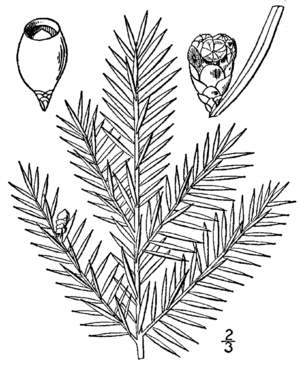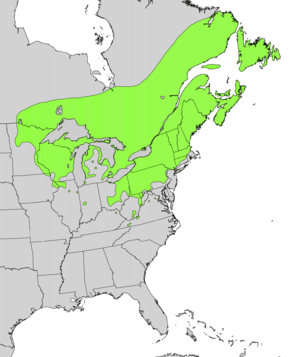Canada yew facts for kids
Quick facts for kids Canada yew |
|
|---|---|
 |
|
| Conservation status | |
| Scientific classification | |
| Genus: |
Taxus
|
| Species: |
canadensis
|
 |
|
| Natural range of T. canadensis | |
| Synonyms | |
|
|
The Canada yew (also called Canadian yew) is a type of conifer plant. It grows naturally in central and eastern North America. You can often find it in wet areas like swamps, riverbanks, and near lakes. People sometimes call it "American yew" or "ground-hemlock."
Most Canada yews grow north of the Ohio River. However, some rare plants can be found in the Appalachian Mountains. These are like living fossils from the last ice age. The southernmost plants are in North Carolina.
Contents
What is the Canada Yew Like?
The Canada yew is usually a spreading shrub. It rarely grows taller than 2.5 meters (about 8 feet). Sometimes it has strong upright main stems. But these stems can only grow from a new seedling plant. They cannot grow from its spreading branches.
Leaves and Bark
This shrub has thin, scaly brown bark. Its leaves are like flat, dark green needles. They are about 1 to 2.5 centimeters (0.4 to 1 inch) long. The needles are arranged in two flat rows along each side of the branch.
How it Makes Seeds
The Canada yew has special seed cones. Each cone holds a single seed. This seed is partly covered by a bright red, soft, berry-like part. This part is called an aril. The aril is open at one end.
Birds like thrushes and waxwings eat these seeds. They then spread the seeds in their droppings. The seeds are very toxic, but the birds are not harmed. The male cones are small and round, about 3 millimeters across. The Canada yew is a monoecious plant. This means it has both male and female parts on the same plant.
Uses and Important Facts
Almost all parts of the Canada yew are toxic, except for the red aril around the seed. However, it is thought to be less toxic than some other yew types.
Traditional Uses
Native tribes in North America used small amounts of yew leaf tea. They used it on the skin or drank it for different health problems. One common use was for rheumatism, which causes joint pain. Tribes also used yew twigs in steam baths to help with rheumatism. Today, herbalists prefer safer plants. This is because the Canada yew is quite toxic.
Modern Medicine Research
The Canada yew is also harvested in parts of Canada. This includes northern Ontario, Québec, and Atlantic Canada. Scientists are interested in the plant because it contains chemicals called taxanes. These chemicals are being studied for cancer research.
The Canada yew is much more common than the Pacific yew. The Pacific yew is a nearly threatened species. People can collect the "greens" (new growth) from Canada yew plants. This can be done every five years without harming the plant. This is a sustainable way to harvest it. It is better than stripping the bark, which can kill the plant.
Images for kids




